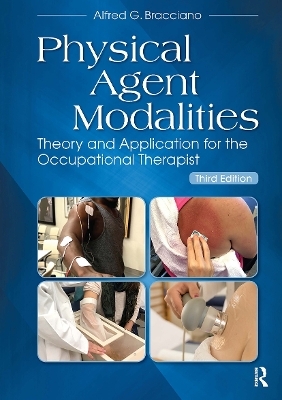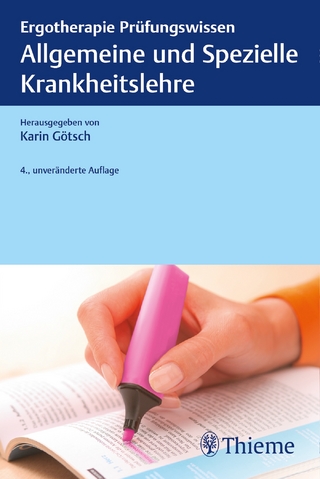
Physical Agent Modalities
SLACK Incorporated (Verlag)
978-1-63091-538-4 (ISBN)
The popular occupational therapy textbook Physical Agent Modalities: Theory and Application for the Occupational Therapist has been newly updated and revised into a comprehensive Third Edition.
Using current occupational therapy terminology and philosophy, this text establishes the theoretical basis and clinical reasoning for the use of physical agent modalities in practice. The biophysiological effects of the modalities are identified and discussed alongside their impact on function and performance. Relevant to both students and practitioners, the Third Edition educates on the proper, safe, and judicious use of physical agent modalities while treating clients.
Written by Dr. Alfred G. Bracciano, this book outlines the application procedures for each modality, indications for their use, and the precautions and contraindications of the modality.
New to the Third Edition:
Organizational boxed asides and tables related to each concept area
Evidence-based research boxes and tables related to clinical reasoning case studies
New chapters on physiological impact of interventions, soft tissue techniques, and health care reform
Global perspective providing a resource for the international therapist
New color flow charts and improved graphics
Each chapter contains:
Learning objectives
Key terms
Case studies
Included with the text are online supplemental materials for faculty use in the classroom.
With up-to-date information and new chapters, Physical Agent Modalities: Theory and Application for the Occupational Therapist, Third Edition provides a user-friendly, organized reference ready to be applied in the clinical setting.
Alfred G. Bracciano, MScA, EdD, OTR/L, FAOTA, is a clinician and academician. He earned his undergraduate degree in Occupational Therapy from Wayne State University (Detroit, Michigan); his Master of Science degree in Hospital and Health Administration at Central Michigan University (Mt. Pleasant, Michigan); and his doctorate in Educational Leadership from Western Michigan University (Kalamazoo, Michigan). He was inducted as a Fellow in the American Occupational Therapy Association (AOTA) for his work in expanding international practice and professional education. Dr. Bracciano holds an academic appointment as Professor at Creighton University, Coordinator of the Creighton University/University of Alaska Pathway; Visiting Professor, Jinan University, Guangzhou, China; and Lecturer, Yonsei University, Seoul, South Korea. Prior to his appointment at Creighton, Dr. Bracciano held appointments as Founding Chair and Professor, Occupational Therapy Program, Saginaw Valley State University in Michigan; as well as Clinical Associate Professor, Stony Brook University in New York. Dr. Bracciano has been a vocal advocate in the appropriate use and application of physical agent modalities and assisted several states and organizations in developing licensing and regulatory guidelines related to their use. He has published and lectured extensively on physical agents, their clinical application, education, and competency in occupational therapy with more than 200 national and international presentations. He is recognized as a subject matter expert on physical agents to the AOTA and the U.S. Department of Defense, U.S. Army. Dr. Bracciano has served on a variety of AOTA committees related to licensing and regulations, scope of practice, and physical agents; coauthored the AOTA Position Statement on Physical Agent Modalities; and contributed chapters to several rehabilitation textbooks, including Radomski and Trombly’s Occupational Therapy for Physical Dysfunction, Fifth and Sixth Editions; Jacobs and MacRae’s Occupational Therapy Essentials for Clinical Competence, Third Edition; and Mahle and Ward’s Adult Physical Conditions: Intervention Strategies for Occupational Therapy Assistants. Dr. Bracciano serves as a reviewer and on editorial boards for the American Journal of Occupational Therapy, British Journal of Occupational Therapy, Journal of Rural Health, Journal of Alternative Complementary & Integrative Medicine, Chinese Journal of Clinical Rehabilitative Tissue Engineering Research, and Journal of Athletic Medicine.
Dedication Acknowledgments About the Author Contributing Author Preface Chapter 1 Physical Agent Modalities: A Theoretical Framework Chapter 2 Regulatory Guidelines for the Use of Physical Agents Addendum: Summary of States Requiring Competency in Physical Agents Chapter 3 Wound Healing Chapter 4 Pain Theory and Perception Chapter 5 Cryotherapy Chapter 6 Thermal Modalities: Therapeutic Heat Chapter 7 Therapeutic Ultrasound and Phonophoresis Chapter 8 Principles of Electrotherapy Chapter 9 Neuromuscular Electrical Stimulation: Applications and Indications Chapter 10 Transcutaneous Electrical Nerve Stimulation Chapter 11 Iontophoresis Chapter 12 Low-Level Laser Therapy, Light Therapy, and Diathermy Appendix A Neuromuscular Electrical Stimulation Hand Rehabilitation Guide Appendix B Neuromuscular Electrical Stimulation Parameter Overview Appendix C Microcurrent Electrical Therapy and Cranial Electrotherapy Stimulation Treatment Protocols Appendix D Considerations, Conditions, Precautions, and Contraindications Index
| Erscheinungsdatum | 15.04.2020 |
|---|---|
| Verlagsort | Thorofare |
| Sprache | englisch |
| Maße | 178 x 254 mm |
| Gewicht | 997 g |
| Themenwelt | Medizin / Pharmazie ► Physiotherapie / Ergotherapie ► Ergotherapie |
| ISBN-10 | 1-63091-538-6 / 1630915386 |
| ISBN-13 | 978-1-63091-538-4 / 9781630915384 |
| Zustand | Neuware |
| Informationen gemäß Produktsicherheitsverordnung (GPSR) | |
| Haben Sie eine Frage zum Produkt? |
aus dem Bereich


